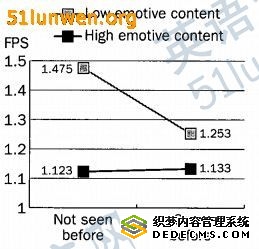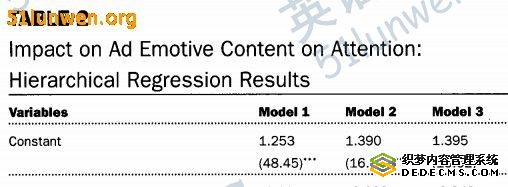美国广告论文 Emotive Content in TV Advertising Does Not Increase Attention
论文作者:留学生论文论文属性:dissertation登出时间:2010-08-31编辑:vshellyn点击率:100
论文字数:10000论文编号:org201008312354439164语种:English地区:USA价格:免费论文
收藏:del.icio.usgoogle书签雅虎搜藏百度搜藏
关键词: 美国广告论文 Emotive ContentTV Advertising Attention
美国广告论文
Emotive Content in TV Advertising Does Not Increase Attention
Emotive creativity is generally believed to facilitate communication by increasingattention. However, during relaxed TV viewing, psychology suggests we may pay lessnot more attention to emotive ads. An experiment conducted in a realistic viewingenvironment found that ads that were high in emotive content correlated with a 20percent lower level of attention and that attention toward these ads was unlikelyto decline on repeat viewing. This supports the idea that TV advertising is notsystematically processed but is automatically processed in response to the stimulipresented. We speculate that emotive creativity may benefit brand TV advertising bylowering attention and inhibiting counter-argument.

 content
content
INTRODUCTION
HOW TV ADVERTISING WORKS—THE CONVENTIONAL VIEW
LEARNING FROM PSYCHOLOGY
Definition of Terms
Emotive Content and Attention
Processing of Emotive Content
HYPOTHESIS DEVELOPMENT
MEASURING ATTENTION
Background
Eye Movement
EXPERIMENT
Method
move their head and body if they wis
Stimuius Materiai
ing. No other instruction
Researcii Materiais
Control Variables
Manipulation Checks
Coding Procedure
Regression Results
REFERENCES
ANDERSON, A. K., AND E. A. PHELPS. "Lesions of
the Human Amygdala Impair Enhanced Per-
ception of Emotionally Salient Events." Nature
411 (2001): 305-9.留学生论文
BAARS, B. J. "Attention Versus Consciousness
in the Visual Brain: Differences In Conception,
Phenomenology, Behavior, Neuroanatomy, and
Physiology." Journal of General Psychology 126, 3
(1999): 224-33.
BARWISE, T. P. , AND A. S. C. EHRENBERG. Televi-
sion and Its Audience. London: Sage Publications,
1998.
BERLYNE, D. E. "Emotional Aspects of Learn-
ing." Annual Review of Psychology 15 (1964):
115-42.
BIEL, A. L. "Love the Ad. Buy the Product?
Why Liking the Advertising and Preferring the
Brand Aren't Such Strange Bedfellows After
All." Admap, September 1990.
BiNET, L., AND P. EiELD. Marketing in the Era of
Accountability. Henley-on-Thames, Oxford:
World Advertising Research Center, 2007.
BRAZEL, S. A. , AND J. GIPS. "Breaking Through
Fast-Forwarding: Brand Information and Visual
Attention." Journal of Marketing 72, 4 (2008):


